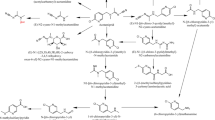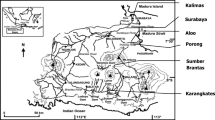Abstract
Chlorpyrifos is a broad-spectrum organophosphorus insecticide (O,O-diethyl -O-3,5,6-trichloro-2-pyridyl phosphorothioate) that is used in numerous agricultural and urban pest controls. The primary metabolite of chlorpyrifos is 3,5,6-trichloro pyridine-2-phenol (TCP). Because of its strong water solubility and mobility, this harmful metabolite exists in the environment in a large amount. Although TCP has potentially harmful effects on organisms in the environment, few studies have addressed TCP pollution. Therefore, this study was undertaken to investigate the effect of chlorpyrifos and TCP on the microsomal cytochrome P450 content in the liver, on the activity of NADPH-P450 reductase and antioxidative enzymes [catalase (CAT) and superoxide dismutase (SOD)], and on reactive oxygen species (ROS) generation and DNA damage in zebrafish. Male and female zebrafish were separated and exposed to a control solution and three concentrations of chlorpyrifos (0.01, 0.1, 1 mg L−1) and TCP (0.01, 0.1, 0.5 mg L−1), respectively, sampled after 5, 10, 15, 20 and 25 days. The results indicated that the P450 content and the NADPH-P450 reductase and antioxidative enzyme (CAT and SOD) activities could be induced by chlorpyrifos and TCP. DNA damage of zebrafish was enhanced with increasing chlorpyrifos and TCP concentrations. Meanwhile, chlorpyrifos and TCP induced a significant increase of ROS generation in the zebrafish hepatopancreas. In conclusion, this study proved that chlorpyrifos (0.01–1 mg L−1) and TCP (0.01–0.5 mg L−1) are both highly toxic to zebrafish.






Similar content being viewed by others
References
Anderson CD, Wang J, Kumar CN (1995) Dexamethasone induction of taxol metaboliam in the rat. Drug Metab Dispos 23:1286–1290
Baskaran S, Kookana RS, Naidu R (2003) Contrasting behaviour of chlorpyrifos and its primary metabolite TCP (3,5,6-trichloro-2-pyridinol), with depth in soil profiles. Aust J Soil Res 41:749–760. doi:10.1071/SR02062
Bokov A, Chaudhuri A, Richardson A (2004) The role of oxidative damage and stress in aging. Mech Ageing Dev 125:811–826. doi:10.1016/j.mad.200407009
Bradford MM (1976) A rapid sensitive method for the quantification of microgram quantities of protein utilizing the principle of protein-dye binding. Anal Biochem 72:248–254. doi:10.1016/0003-2697(76)90527-3
Brandes RP, Janiszewski M (2005) Direct detection of reactive oxygen species ex vivo. Kidney Int 67:1662–1664. doi:10.1111/j.1523-1755.2005.00258.x
Casadevall M, Fresco PdC, Kortenkamp A (1999) Chromium(VI)-mediated DNA damage: oxidative pathways resulting in the formation of DNA breaks and abasic sites. Chem Biol Interact 123:117–132. doi:10.1016/S0009-2797(99)00128-3
Contardo-Jara V, Galanti L, Ame M, Monferran M, Wunderlin D, Wiegand C (2009) Biotransformation and antioxidant enzymes of Limnoperna fortunei detect site impact in watercourses of Cordoba, Argentina. Ecotoxicol Environ Safe 72:1871–1880. doi:10.1016/j.ecoenv.2009.07.001
David S, Stuart H (1998) Analytical chemistry of chlorpyrifos and diuron in aquatlc ecosystems. Anal Chim Acta 360:1–16. doi:10.1016/S00032670(97)006806
Debnath D, Mandal TK (2000) Study of quinalphos (an environmental oestrogenic insecticide) formulation (Ekalux 25 E.C.)-induced damage of the testicular tissues and antioxidant defense systems in Sprague-Dawley albino rats. Appl Toxicol 20:197–204. doi:10.1002/(SICI)1099-1263(200005/06)20:3
Deventer K (1996) Detection of genotoxic effects on cells of liver and gills of B. rerio by means of single cell gel electrophoresis. Bull Environ Contam Toxicol 56:911–918. doi:10.1007/s001289900132
Diekmann M, Hultsch V (2004) Nagel R On the relevance of genotoxicity for fish populations I: effects of a model genotoxicant on zebrafish (Danio rerio) in a complete life-cycle test. Aquat Toxicol 68:13–26. doi:10.1016/j.aquatox.01.020
Dong XL, Zhu LS, Wang JH, Wang J, Xie H, Hou XX, Jia WT (2009) Effects of atrazine on cytochrome P450 enzymes of zebrafish (Danio rerio). Chemosphere 77:404–412. doi:10.1016/j.chemosphere.2009.06.052
Dorval J, Leblond VS, Hontela A (2003) Oxidative stress and loss of cortisol secretion in adrenocortical cells of rainbow trout (Oncorhynchus mykiss) exposed in vitro to endosulfan, an organochlorine pesticide. Aquat Toxicol 63:229–241. doi:10.1016/S0166-445X(02)00182-0
Gamo M, Oka T, Nakanishi J (2003) Ranking the risks of 12 major environmental pollutants that occur in Japan. Chemosphere 53:277–284. doi:10.1016/S0045-6535(03)00053-5
Kosmehl T, Hallare AV, Braunbeck T, Hollert H (2008) DNA damage induced by genotoxicants in zebrafish (Danio rerio) embryos after contact exposure to freeze-dried sediment and sediment extracts from Laguna Lake (The Philippines) as measured by the comet assay. Mutat Res 650:1–14. doi:10.1016/j.mrgentox.2007.09.009
Lawler JM, Song W, Demaree SR (2003) Hindlimb unloading increases oxidative stress and disrupts antioxidant capacity in skeletal muscle. Free Radical Biol Med 35:9–16. doi:10.1016/S0891-5849(03)00186-2
Levin ED, Swain HA, Donerly S, Linney E (2004) Developmental chlorpyrifos effects on hatchling zebrafish swimming behavior. Neurotoxicol Teratol 26:719–723. doi:10.1016/j.ntt.2004.06.013
Li D, Yang XL, Zhang SJ, Lin M, Yu WJ, Hu K (2008) Effects of mammalian CYP3A inducers on CYP3A-related enzyme activities in grass carp (Ctenopharyngodon idellus): possible implications for the establishment of a fish CYP3A induction model. Comp Biochem Phys C 147:17–29. doi:10.1016/j.cbpc.2007.07.003
Liu W, Zhu LS, Wang J, Wang JH, Xie H, Song Y (2009) Assessment of the genotoxicity of endosulfan in earthworm and white clover plants using the comet assay. Arch Environ Contam Toxicol 56:742–746. doi:10.1007/s00244-009-9309-8
Luo H, Lu YD, Mao Y, Shi XL, Dalai NS (1996) Role of chromium(IV) in the chromium(VI)-related free radical formation, dG hydroxylation, and DNA damage. Inorg Biochem 64:25–35. doi:10.1016/0162-0134(95)00241-3
Meeker JD, Singh NP, Ryan L, Duty SM, Barr DB, Herrick RF, Bennett DH, Hauser R (2004) Urinary levels of insecticide metabolites and DNA damage in human sperm. Hum Reprod 19:2573–2580. doi:10.1093/humrep/deh444
Meeker JD, Barr DB, Hauser R (2006) Thyroid hormones in relation to urinary metabolites of non-persistent insecticides in men of reproductive age. Reprod Toxicol 22:437–442. doi:10.1016/j.reprotox.2006.02.005
Mittler R (2002) Oxidative stress, antioxidants and stress tolerance. Trends Plant Sci 7:405–410. doi:10.1016/S1360-1385(02)02312-9
O’Brien TJ, Ceryak S, Patierno SR (2003) Complexities of chromium carcinogenesis: role of cellular response, repair and recovery mechanisms. Mutat Res 533:3–36. doi:10.1016/j.mrfmmm.2003.09.006
Oliveira M, Maria VL, Ahmad I, Serafim A, Bebianno MJ, Pacheco M, Santos MA (2009) Contamination assessment of a coastal lagoon (Ria de Aveiro, Portugal) using defence and damage biochemical indicators in gill of Liza aurata: an integrated biomarker approach. Environ Pollut 157:959–967. doi:10.1016/j.envpol.2008.10.019
Omura T, Sato R (1964a) The carbon monoxide-binding pigment of liver microsomes. I. Evidence for its hemoprotein nature. J Biol Chem 239:2370–2378
Omura T, Sato R (1964b) The monoxide-binding pigment of liver microsomes. II. Solubilization, purification, and properties. J Biol Chem 239:2379–2385
Otte JC, Andersson C, Abrahamson A, Olsman H, Keiter S, Engwall M, Hollert H, Brunström B (2008) A bioassay approach to determine the dioxin-like activity in sediment extracts from the Danube River: ethoxyresorufin-Odeethylase induction in gill filaments and liver of three-spined sticklebacks (Gasterosteus aculeatus L.). Environ Int 34:1176–1184. doi:10.1016/j.envint.2008.05.004
Petty DG, Skogerboe JG, Getsinger KD, Foster DR, Houtman BA, Fairchild JF, Anderson LW (2001) The aquatic fate of triclopyr in whole-pond treatments. Pest Manag Sci 57:764–775. doi:10.1002/ps.343
Piña-Guzmán B, Solís-Heredia MJ, Rojas-Garcí AE, Urióstegui-Acosta M, Quintanilla-Vega B (2006) Genetic damage caused by methyl–parathion in mouse spermatozoa is related to oxidative stress. Toxicol Appl Pharmacol 216:216–224. doi:10.1016/j.taap.2006.05.001
Possamai FP, Fortunato JJ, Feier G, Agostinho FR, Quevedo J, Wilhelm Filho D, Dal-Pizzol F (2007) Oxidative stress after acute and sub-chronic malathion intoxication in Wistar rats. Environ Toxicol Pharmacol 23:198–204. doi:10.1016/j.etap.2006.09.003
Rahman MF, Mahboob M, Danadevi K, Saleha BB, Grover P (2002) Assessment of genotoxic effect chloropyriphos and acephate by the comet assay in mice leucocytes. Mutat Res 516:139–147. doi:10.1016/S1383-5718(02)00033-5
Rao JV, Rani CHS, Kavitha P, Rao RN, Madhavendra SS (2003) Toxicity of Chlorpyrifos to the fish oreochromis mossambicus. Environ Contam Toxicol 70:985–992. doi:10.1007/s00128-003-0079-0
Sandah JF, Baldwin DH, Jenkins JJ, Scholz NL (2005) Comparative thresholds for acetylcholinesterase inhibition and behavioral impairment in coho salmon exposed to chlorpyrifos. Environ Toxicol Chem 24:136–145. doi:10.1897/04-195R.1
Schnabel D, Salas-Vidal E, Narváez V, Sánchez-Carbente MdR, Hernández-García, D, Cuervo R, Covarrubias L (2006) Expression and regulation of antioxidant enzymes in the developing limb support a function of ROS in interdigital cell death. Dev Biol 291:291–299. doi:10.1016/j.ydbio.2005.12.023
Seitz N, Böttcher M, Keiter S, Kosmehl T, Manzb W, Hollert H, Braunbeck T (2008) A novel statistical approach for the evaluation of comet assay data. Mutat Res 652:38–45. doi:10.1016/j.mrgentox.2007.12.004
Serrano R, López FJ, Hernández F, Peña2 JB (1997) Bioconcentration of chlorpyrifos, Chlorfenvinphos, and Methidathion in Mytilus galloprovincialis. Environ Contam Toxicol 59:68–975. doi: 10.1007/s001289900577
Sharma Y, Bashir S, Irshad M, Datta Gupta S, Dogra TD (2006) Effects of acute dimethoate administration on antioxidant status of liver and brain of experimental rats. Toxicology 206:49–57. doi: 10.1016/j.tox.2004.06.062
Singh NP, McCoy MT, Tice RR, Schneider EL (1988) A simple technique for quantitation of low levels of DNA damage in individual cells. Exp Cell Res 175:184–191. doi:10.1016/0014-4827(88)90265-0
Solé M, Barceló D, Porte C (2002) Seasonal variation of plasmatic and hepatic vitellogenin and EROD activity in carp, Cyprinus carpio, in relation to sewage treatment plants. Aquat Toxicol 60:233–248. doi:10.1016/S0166-445X(02)00009-7
Streisinger G, Walker C, Dower N, Knauber D, Singer F (1981) Production of clones of homozygous diploid zebra fish (Brachydanio rerio). Nature 291:293–296. doi:10.1038/291293a0
Sun Y, Oberley LW, Li Y (1988) A simple method for clinical assay of superoxide dismutase. Clin Chem 34:497–500
Sun LW, Qu MM, Li YQ, Wu YL, Chen YG, Kong ZM, Liu Z (2004) Toxic effects of aminophenols on aquatic life using the Zebrafish embryo test and the comet assay. Bull Environ Contam Toxicol 73:628–634. doi:10.1007/s00128-004-0474-1
Wang XF, Xing ML, Shen Y, Zhu X, Xu LH (2006) Oral administration of Cr(VI) induced oxidative stress, DNA damage and apoptotic cell death in mice. Toxicol. doi:10.1016/j.tox.2006.08.005
Williams CH, Kamin H (1962) Microsomal triphosphopyridine nucleotide- cytochrome c reductase of liver. J Biol Chem 237:587–595
Xu JB, Yuan XF, Lang PZ (1997) Determination of catalase activity and catalase inhibition by ultraviolet spectrophotometry. Chin J Environ Chemy 16:73–76
Zhu LS, Dong XL, Xie H, Wang J, Wang JH, Su J, Yu CW (2010) DNA damage and effects on glutathione-s-transferase activity induced by atrazine exposure in zebrafish (Danio rerio). Environ Toxicol. doi:10.1002/tox.20575
Acknowledgments
This study was supported by grants from the National Science Foundation of China (No. 41071164, 21277083, 21377075, and 41001152) and the Specialized Research Fund for the Doctoral Program of Higher Education (20113702110007).
Conflict of interest
The authors declare that they have no conflict of interest.
Author information
Authors and Affiliations
Corresponding authors
Rights and permissions
About this article
Cite this article
Wang, J., Wang, J., Zhu, L. et al. The enzyme toxicity and genotoxicity of chlorpyrifos and its toxic metabolite TCP to zebrafish Danio rerio . Ecotoxicology 23, 1858–1869 (2014). https://doi.org/10.1007/s10646-014-1321-8
Accepted:
Published:
Issue Date:
DOI: https://doi.org/10.1007/s10646-014-1321-8




